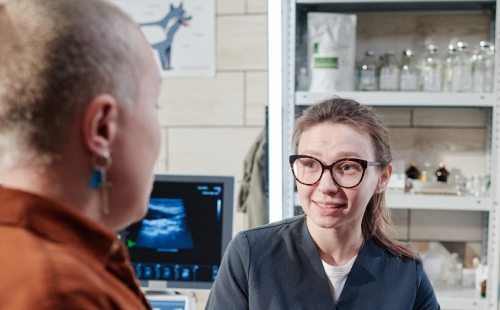Feeding on Feedback: The Role of Veterinary Client Surveys

Veterinary medicine relies on client relationships, which require ongoing nurturing to thrive. Constantly evaluating and refining client service strategies, including communication methods and efficacy, can help ensure you meet or exceed expectations. One important strategy for setting and assessing team and practice goals is soliciting and acting on feedback gathered with various digital tools, including veterinary client surveys.
Anonymous veterinary client surveys allow clients to communicate feedback in a low-stakes, non-confrontational manner—and will include clients who are uncomfortable posting online reviews or bringing their concerns directly to team members. Survey results can help you pinpoint and address concerning areas and highlight and celebrate all that the team does well.
Using client surveys
With veterinary client surveys, you can gather client opinions with a structured, consistent method. Surveys give clients a voice while allowing them to remain anonymous, which can encourage honesty. Survey results help veterinary teams refine client interactions, medical protocols, and other business areas to address actual—rather than assumed—client needs and concerns, and allow practice leaders to focus time and resources where they are most needed. Plus, veterinary client surveys are customizable and easily lend themselves to automated distribution, gathering more responses without taking up team members’ time.
Client survey contents
Asking the right questions is vital for generating actionable insights. For practices looking for overall feedback, ask a few general, open-ended questions about the client’s last visit. Ask about wait times, team member attitudes and helpfulness, hospital appearance, perceived service value, and anything else the client wants to share or discuss. Asking basic demographic questions can also help you better understand your client base. Keep surveys short to encourage clients to finish and ensure questions don’t leave room for ambiguous interpretation.
Teams looking to address client communication and customer service should consider exploring questions in these areas:
- Preferred communication methods: Do clients prefer phone calls, emails, text messages, or mobile apps?
- Messaging efficacy: Do clients receive timely reminders and updates, and is the information presented clearly?
- Appointment scheduling: Do clients find appointment scheduling easy, or would they prefer more convenient options, like online booking?
- Follow-ups: If clients leave but then have more questions, can they easily reach someone? Are test results discussed in a timely and professional manner?
- Empathy and compassion: Do clients feel heard and understood during interactions with the veterinary team?
- Digital communications: Do clients use and understand online tools, or do they cause confusion?
Analyzing survey results
Once you’ve collected survey responses, you need to analyze the data. Look for trends and common themes, rather than focusing on outliers. What are the most common client pain points? Prioritize these areas by investigating client feedback and creating a plan to address it.
For example, if clients frequently mention delayed email responses, call a team member meeting to discuss the feedback. What is the current protocol for returning emails? Should it be overhauled? Are team members too busy to respond promptly? Is the email response time reasonable, but clients expect a different timeframe? An open, non-judgmental group discussion can help pinpoint the issue underlying the negative client perception.
Ensure the team knows not only the survey concerns, but also what they are doing well. Highlight positive survey responses and call out any team members mentioned specifically, which will encourage continued commitment to client satisfaction.
Addressing client feedback
After determining the reasons behind the negative client survey responses, work as a team to implement strategies that address the issues. Operating at peak performance requires ongoing adaptation and a willingness to examine and adjust protocols as client needs and expectations change. Some possible solutions to address communication or service gaps include:
- Introduce new technologies — Mobile apps, full-featured veterinary management software, or online booking can drastically alter the client experience.
- Standardize protocols — Creating written protocols keeps client interactions consistent and reduces errors.
- Train the team — Provide internal or external training to address individual team member weaknesses or enroll the entire team in a training course.
Surveys are powerful communication tools for veterinary practices looking to improve the client experience. Gathering and analyzing client feedback allows teams to see client perspectives and directly address their concerns. Veterinary practices can use surveys to help clients feel heard, which can build trust, strengthen relationships, and create lasting loyalty.




